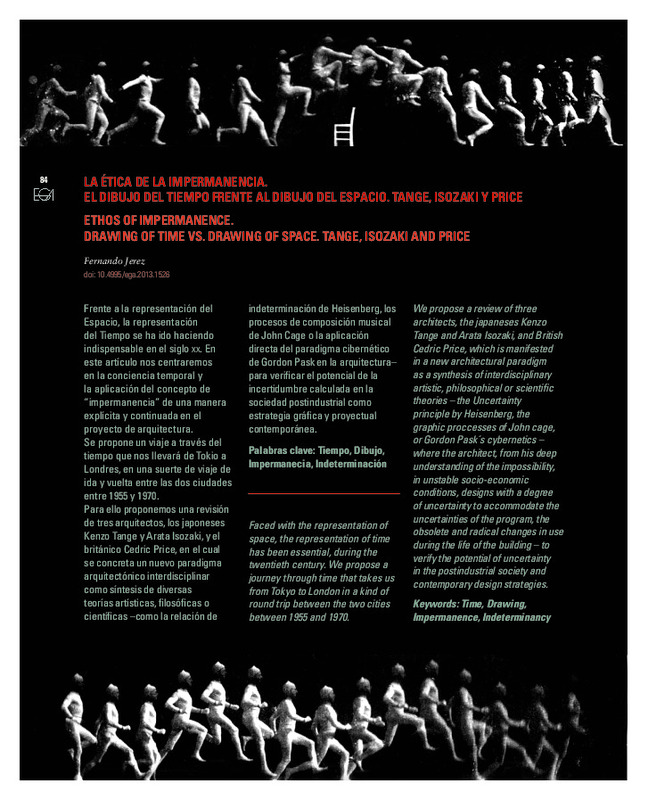JavaScript is disabled for your browser. Some features of this site may not work without it.
Buscar en RiuNet
Listar
Mi cuenta
Estadísticas
Ayuda RiuNet
Admin. UPV
La ética de la impermanencia. El dibujo del tiempo frente al dibujo del espacio. Tange, Iisozaki y Price
Mostrar el registro sencillo del ítem
Ficheros en el ítem
| dc.contributor.author | Jerez, Fernando
|
es_ES |
| dc.date.accessioned | 2013-09-25T08:01:17Z | |
| dc.date.issued | 2013 | |
| dc.identifier.issn | 1133-6137 | |
| dc.identifier.uri | http://hdl.handle.net/10251/32334 | |
| dc.description.abstract | [EN] Faced with the representation of space, the representation of time has been essential, during the twentieth century. We propose a journey through time that takes us from Tokyo to London in a kind of round trip between the two cities between 1955 and 1970. We propose a review of three architects, the japaneses Kenzo Tange and Arata Isozaki, and British Cedric Price, which is manifested in a new architectural paradigm as a synthesis of interdisciplinary artistic, philosophical or scientific theories ¿ the Uncertainty principle by Heisenberg, the graphic proccesses of John cage, or Gordon Pask¿s cybernetics ¿ where the architect, from his deep understanding of the impossibility, in unstable socio-economic conditions, designs with a degree of uncertainty to accommodate the uncertainties of the program, the obsolete and radical changes in use during the life of the building ¿ to verify the potential of uncertainty in the postindustrial society and contemporary design strategies. | es_ES |
| dc.description.abstract | [ES] Frente a la representación del Espacio, la representación del Tiempo se ha ido haciendo indispensable en el siglo XX. En este artículo nos centraremos en la conciencia temporal y la aplicación del concepto de ¿impermanencia¿ de una manera explícita y continuada en el proyecto de arquitectura.Se propone un viaje a través del tiempo que nos llevará de Tokio a Londres, en una suerte de viaje de ida y vuelta entre las dos ciudades entre 1955 y 1970.Para ello proponemos una revisión de tres arquitectos, los japoneses Kenzo Tange y Arata Isozaki, y el británico Cedric Price, en el cual se concreta un nuevo paradigma arquitectónico interdisciplinar como síntesis de diversas teorías artísticas, filosóficas o científicas - como la relación de indeterminación de Heisenberg, los procesos de composición musical de John Cage o la aplicación directa del paradigma cibernético de Gordon Pask en la arquitectura para verificar el potencial de la incertidumbre calculada en la sociedad postindustrial como estrategia gráfica y proyectual contemporánea. | es_ES |
| dc.language | Español | es_ES |
| dc.language | Inglés | |
| dc.publisher | Editorial Universitat Politècnica de València | |
| dc.relation.ispartof | EGA. Revista de Expresión Gráfica Arquitectónica | |
| dc.rights | Reserva de todos los derechos | es_ES |
| dc.subject | Time | es_ES |
| dc.subject | Drawing | es_ES |
| dc.subject | Impermanence | es_ES |
| dc.subject | Indeterminancy | es_ES |
| dc.subject | Tiempo | es_ES |
| dc.subject | Dibujo | es_ES |
| dc.subject | Impermanecia | es_ES |
| dc.subject | Indeterminación | es_ES |
| dc.title | La ética de la impermanencia. El dibujo del tiempo frente al dibujo del espacio. Tange, Iisozaki y Price | es_ES |
| dc.title.alternative | Ethos of impermanence.Drawing of time vs. drawing of space. Tange, Isozaki and Price | es_ES |
| dc.type | Artículo | es_ES |
| dc.date.updated | 2013-09-24T09:44:46Z | |
| dc.identifier.doi | 10.4995/ega.2013.1526 | |
| dc.rights.accessRights | Abierto | es_ES |
| dc.description.bibliographicCitation | Jerez, F. (2013). La ética de la impermanencia. El dibujo del tiempo frente al dibujo del espacio. Tange, Iisozaki y Price. EGA. Revista de Expresión Gráfica Arquitectónica. 18(21):84-95. https://doi.org/10.4995/ega.2013.1526 | es_ES |
| dc.description.accrualMethod | SWORD | es_ES |
| dc.relation.publisherversion | https://doi.org/10.4995/ega.2013.1526 | es_ES |
| dc.description.upvformatpinicio | 84 | es_ES |
| dc.description.upvformatpfin | 95 | es_ES |
| dc.description.volume | 18 | |
| dc.description.issue | 21 | |
| dc.identifier.eissn | 2254-6103 |








